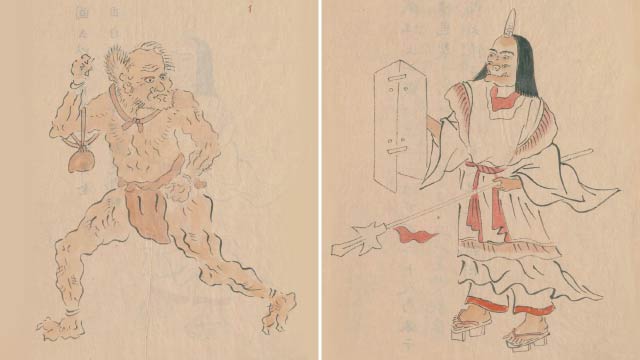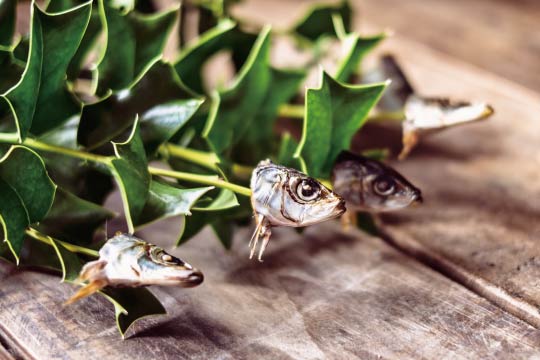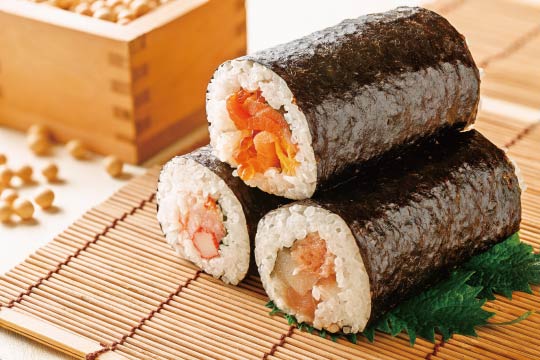News & Blogs
Demons hate roasted beans. Let's scatter some to drive them away! (豆まき mame-maki)
Grilled sardines speared by holly twigs (柊鰯/焼い嗅がし hiiragi-iwashi/yaikogashi), the holly and smelly guard protects the front door.
Turn your face toward the lucky direction, then keep calm and eat sushi (恵方巻 Ehomaki)
In this blog, we touch on diverse topics about Japanese food cultures, practices together with the culinary secret, TREHA®, and its important role in the Japanese food industry. We hope our blog helps you obtain in-depth knowledge of the secrets and science behind Japanese cuisine, shared from our kitchen, to yours.
The event’s name, Setsubun (節分), means "separate the seasons" in kanji characters, referring to the days before the beginning of spring, summer, autumn, and winter, which come around four times a year. However, the one in February became prominent as a seasonal event in Japan. Food items closely related to the traditional event are beans, sardines, and large sushi rolls. Today we would like to introduce the roles such food items play in the event.
Roasted Beans are to drive the demons away from the house.
On the “Setsubun,” people scatter beans to drive away demons and invite good luck. The custom is called “mame-maki.” Like many Japanese traditional events, the Japanese bean throwing tradition, mame-maki, is derived from the Imperial Court event during the Heian period (8th-12th century). This unique activity is called "Tsuina (追儺),” rooted in an ancient Chinese custom.
Tsuina is a ritual performed by the Hososhi (方相氏), the officer who drives away demons wearing a mask printed with four eyes acting as a creature who is believed to hunt down evil demons. The ritual is held in early February when the winter starts shifting toward spring, causing dramatic weather changes. It was believed this was the exact time when demons brought illness and disaster to the people. Thus, Hososhi is in charge of ousting the demons related to the epidemic and welcoming the spring weather and good fortune.
Due to the influence of manga and anime (Demon Slayer: Kimetsu no Yaiba), young folks might think slaying demons is the way to get rid of them, but driving away demons is more historically accurate to remove them.
The oldest record of scattering beans to dispel demons was in the Muromachi period (15th century). Although there are various theories on why beans were chosen over other grains, the well-known one is that "mame (豆),” meaning "beans" in Japanese, has precisely the same pronunciation as "extermination of demons (魔滅 mame),” thus beans have such power.
Though the throwing bean tradition varies depending on the region, this is the most typical example. First, roasted beans are used instead of raw, live beans as they are sacrificed to remove all the previous year’s illnesses, and disasters brought by demons. Some regions customarily offer roasted soybeans to the Household Shinto altar before use. Since it is believed that demons come at night, beans are scattered after dark, led by the patriarch and a man born in a year with the same sign of the Chinese zodiac as the current year, called Toshi Otoko (年男).
When night falls, people open the windows and doors and scatter the beans while yelling "Oni wa Soto! (鬼は外)", meaning "Demons out!" The action starts in the backroom and finishes at the front door. As soon as kicking out the demons, people close the door and then scatter beans into the house while yelling, "Fuku wa Uchi (福は内)," indicating "Good luck in!" After the ritual, people eat as many beans as their age, wishing good health.
In some areas, including the northeast regions of Japan where I grew up, peanuts in pods are often used instead of roasted soybeans for two practical reasons: First, peanuts are easier to clean up than soybeans. Second, the nuts inside stay clean and edible even when they fall to the floor.
For the elderly who cannot eat a lot of beans, a tea called "Fukucha (福茶 lucky tea)" is substituted, which is made by pouring hot water into the same number of beans of their age. Fukucha is believed to have the same benefits as eating beans themselves.
This seasonal event is also held in preschools during the daytime. Kids enjoy making demon masks and throwing beans at their teachers dressed as demons. Older children bravely confront the fake demons, but younger children often start crying scared. Meantime, the fear spread among children, and the whole room could turn into pandemonium filled with screams and tears. However, this can also be a good childhood memory. The teachers are careful not to scare the children more than necessary, avoiding trauma.

Grilled sardine heads pierced with holly twigs: Let’s grill sardines to make the ornament. (柊鰯/焼い嗅がし hiiragi-iwashi/yaikogashi)
Now that mame-maki (豆まき) for driving away the demons is completed, we must prevent them from re-entering the house. Sardines (鰯 iwashi) play an active part. "Hiiragi iwashi (柊鰯),” meaning "holly twigs and sardine," is grilled sardine heads speared with holly twigs to be hung at the front door. In Western Japan, it is also called "yaikogashi (焼い嗅がし),” meaning "grilled stink.”
It is believed that demons cannot pass through the gate because of the odor and smoke from the grilled sardines while the thorns of the holly leaves pierce their eyes. Some areas support the theory to lure the demons with the smell of grilled sardines and attack them with the thorns of the holly leaves. The latter theory makes more sense since I love grilled sardines, which wonderfully pair with sake.
Though there is no particular time frame to display the sardine heads with holly twigs, they are commonly displayed on the day of Setsubun only. The time frame varies by region, from mid-January to Setsubun or Setsubun to the end of February. Some areas continue to display the holly but smelly ornaments until a cat finishes off the sardines’ heads!

Large sushi roll: Turn your face toward the lucky direction of the year and eat the whole roll without a word! (恵方巻 Ehomaki)
"Eho (恵方)" means the lucky direction of the year where the deity of the year resides. Because the Zodiac determines the lucky direction, it changes every year. The lucky direction in 2022 is supposedly north-northwest. It is said that the wish will come true if you finish the whole sushi roll without words while keeping your face in the lucky direction and your desire in your mind. A whole sushi roll is a lucky charm because it is believed to wrap fortune in a full roll allowing the consumer to stay connected with good luck without intermissions.
The Ehomaki (恵方巻) sushi rolls are said to have started from the Edo to the Meiji period (late 19th century) to celebrate Setsubun (節分) and pray for prosperous business in a Geisha quarter in Osaka. However, there is no established theory for its origin.
The Ehomaki (恵方巻) generally refers to a giant sushi roll containing fillings with seven ingredients taken after Shichi-fuku-jin, the seven deities worshiped in Japan to bring good fortune. Still, there seem to be no specific detailed rules. For ease of consumption, smaller-sized rolls are available such as half-cut rolls, medium-thin rolls, and hand-rolled sushi.
"Ehomaki (恵方巻)" was supposedly invented by one convenience store chain that started selling large sushi rolls in Hiroshima Prefecture. After that, the lucky sushi roll quickly spread throughout Japan. While some people enjoy making their own Ehomaki at home, department stores and supermarkets entered the market following the convenience store chains. Yes, sushi restaurants carry the rolls. As Setsubun (節分) season approaches, supermarkets, convenience stores, and department stores begin to announce the pre-order sale of Ehomaki with their marketing flares: Some sushi rolls are wrapped with Nori seaweed sheets that are prayed at famous temples or shrines. Some are supervised by renowned restaurants. Some feature limited edition packaging with popular anime characters. The sellers are hard at work to differentiate their offerings to win over customers.
In addition to the sushi rolls, its sweet counterpart, “Ehomaki Swiss rolls," started to show up at the storefront. As long as it is rolled up, any food can be Ehomaki.
Let your imagination fly. What would you roll up for Setsubun?

Did you find this blog interesting?
Please share it with your friends in the food service industry.
We regularly update the blog about the food culture of Japan, where TREHA® was discovered for culinary applications.
Click here and send us a message to subscribe.
Or hit us up on Instagram @trehalose_sensei!
You might also be interested in:
Japanese traditional food series 2: Chitose Ame, candy for healthy longevity (千歳飴)
Japanese traditional food series 3: Yuzu (柚子) and the winter solstice
Japanese traditional food series 4: Noodles on New Year's Eve (年越しそば)
Japanese traditional food series 5: Japanese traditional New Year’s dishes, Osechi-ryori (おせち料理)
Japanese traditional food series 6: Another traditional food for New Year’s celebration, mochi (餅)
Japanese traditional food series 13: Inari sushi offered to a deity of harvests

